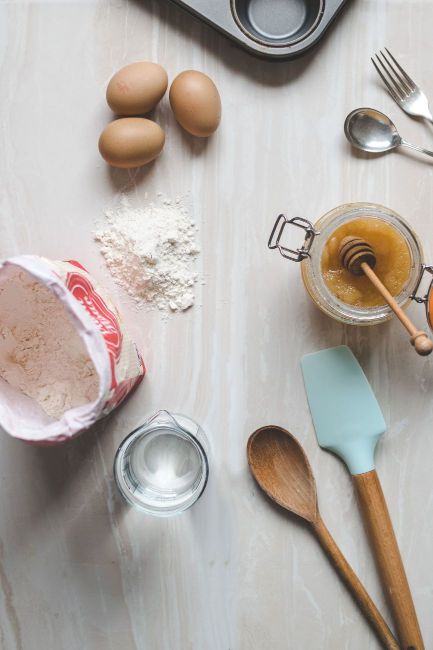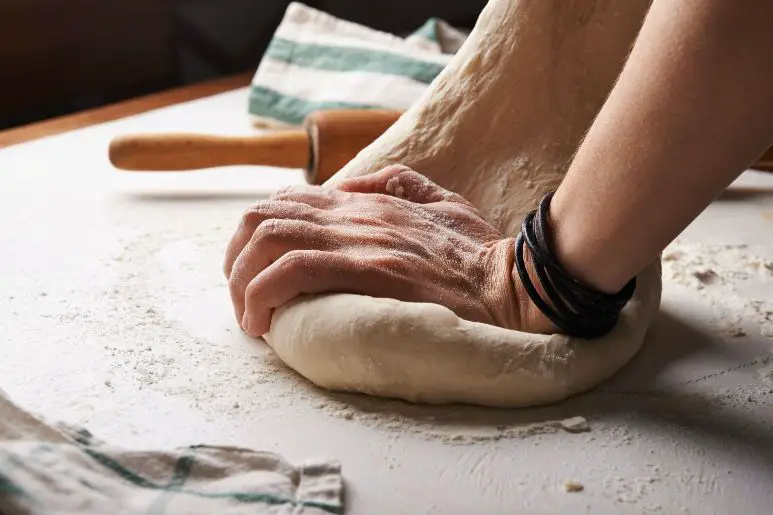Bread, a staple food enjoyed by many, can sometimes be a source of frustration when it turns out dense instead of light and airy.
The art of bread-making involves various factors, and understanding why your bread is dense is crucial to creating delightful, palatable loaves.
In this article, I’ll reveal the common reasons behind dense bread and provide actionable solutions to help you achieve bakery-worthy results right in your kitchen.
So, if you’ve been wondering, why is my bread so dense? keep reading to find out.
Why is My Bread So Dense – Revealed
Dense bread can stem from various factors, ranging from ingredients to techniques.
Here are some potential culprits:
1. Yeast Quantity and Activation
Having an insufficient amount of yeast or not activating it properly can result in bread that is dense in texture.
Yeast plays a vital role in causing the dough to rise, and if the yeast doesn’t become active enough, the dough will not expand as it should during the baking process.
To ensure that yeast becomes optimally active, a recommended method is to proof it with warm water and a small amount of sugar before incorporating it into the dough.
This process helps confirm that the yeast is alive and ready to contribute to the dough’s rise.
2. Overmixing the Dough
Excessive mixing of the dough can lead to the excessive development of gluten.
While gluten is necessary for providing structure to the bread, an excessive amount of it can give the bread a tough and dense consistency.
When the dough is mixed for too long, the gluten strands become overly interconnected, resulting in a chewier end product.
To avoid this issue, you should mix the dough just until the ingredients are combined. This approach prevents the gluten from becoming overly developed and allows the bread to have a softer texture.
3. Insufficient Proofing Time
Properly allowing the dough to undergo proofing is essential for achieving a well-risen bread with a desirable flavor profile.
Rushing through this step can lead to insufficient expansion of the dough during baking, ultimately leading to a denser final product.
To ensure optimal results, you should provide the dough with ample time to proof. This involves letting the dough sit and rise until it has doubled in size.
This extended period allows the yeast to generate gases that expand within the dough, creating air pockets that contribute to a lighter texture in the finished bread.
Moreover, the longer proofing time also enhances the development of complex flavors in the bread.
4. Incorrect Flour-to-Water Ratio
Maintaining the correct balance between flour and water is pivotal in achieving the desired consistency for the dough.
Using too much flour can make the dough overly stiff, restricting its ability to rise properly during baking.

Conversely, too much water can cause the dough to become sticky and challenging to handle.
To achieve the ideal dough consistency, you should follow a trusted recipe that provides specific measurements for both flour and water.
If necessary, adjustments can be made based on factors such as humidity levels in your environment.
Achieving the right flour-to-water ratio ensures that the dough is manageable, can rise effectively, and results in a well-textured final product.
5. Inadequate Kneading
Kneading is a crucial step in bread-making that serves multiple purposes.
It not only evenly distributes yeast throughout the dough but also promotes the development of gluten, which gives the bread its structure.
Additionally, proper kneading ensures a uniform texture in the final product.
When kneading is insufficient, the yeast might not be evenly distributed, leading to uneven rising and an end result with a dense, heavy crumb.
6. Improper Shaping
The manner in which you shape the dough before its final rise holds significant importance.
Inadequate shaping can inadvertently trap pockets of air within the dough, causing an irregular distribution of air bubbles and ultimately resulting in a dense interior texture in the finished loaf.

To overcome this, it’s beneficial to practice appropriate shaping techniques.
These techniques help create a well-shaped and consistent loaf by allowing for an even distribution of air and ensuring a more uniform rise during baking.
7. Adding Too Many Mix-ins
Incorporating additional ingredients like nuts, seeds, or other mix-ins can indeed enhance the flavor and texture of your bread.

However, it’s important to exercise caution when adding these extras. Excessive amounts of mix-ins can actually have a negative impact on the dough’s overall quality.
This is because an overwhelming quantity of these additions can weigh down the dough, preventing it from achieving the desired lightness and resulting in a loaf with a denser consistency.
To strike the right balance, you should incorporate mix-ins in moderation, allowing you to enjoy the benefits they bring without compromising the bread’s structure.
8. Too much Salt
Salt plays a vital role in the bread-making process by regulating yeast activity. Its presence helps control the fermentation process that leads to dough rising.
However, when salt is added excessively, it can unintentionally hinder this fermentation process.
Yeast operates optimally within a specific salt-to-flour ratio. Too much salt can interfere with yeast’s ability to ferment, leading to an extended rise time or even a limited rise.
This prolonged fermentation period significantly impacts the overall texture of the bread, potentially resulting in a denser crumb structure and a less appealing flavor profile.
Therefore, it’s crucial to measure and use salt carefully and in moderation. This ensures that yeast functions as intended, guaranteeing the best possible quality of the final bread product.
What To Do if Bread Is Too Dense? 7 Things To Do
If you’ve encountered the unfortunate situation of slicing into a loaf of bread only to find it disappointingly dense, fear not!
Here are some ways to prevent it from happening in the first place:
1. Adjust the Recipe
One of the initial and critical measures to take to prevent the formation of dense bread is to ensure that your recipe is meticulously balanced.
Take the time to review the measurements of all the ingredients, with special attention to the ratio of flour to water.
It’s important to be cautious about adding excessive flour, as this can result in a more compact and heavy texture in the bread.
To achieve precise measurements, you should use a kitchen scale.
2. Knead the Dough Thoroughly
Proper and thorough kneading plays a pivotal role in the development of gluten within the bread, which in turn impacts the structural integrity.

If you find that your bread has turned out dense, it’s quite possible that the dough didn’t undergo sufficient kneading.
In such cases, dedicating a few extra minutes to kneading can make a significant difference.
The aim is to knead the dough until it reaches a state of smoothness, elasticity, and a slightly tacky consistency.
This process contributes to the proper alignment and formation of gluten strands, which are crucial for a light and airy final texture.
3. Incorporate Vital Wheat Gluten
Vital wheat gluten proves to be a valuable ingredient that holds the potential to revolutionize the density of your bread.
It serves the purpose of enhancing the dough’s elasticity and effectively contributes to the creation of a more delicate and airy structure.
To leverage its benefits, consider adding approximately one tablespoon of vital wheat gluten for every cup of flour used in your recipe.
This adjustment has the potential to yield notably improved results in terms of the bread’s texture and overall quality.
4. Allow for Sufficient Proofing
Proofing, which involves allowing the dough to rise, holds immense significance in the bread-making process.

When the proofing time falls short, it can lead to the formation of a compact loaf with poor texture.
To prevent this, adhere to the recommended proofing durations mentioned in the recipe.
Furthermore, you might want to contemplate extending the proofing time slightly, especially in a warm and draft-free environment.
This additional time can facilitate better fermentation and development of the dough, ultimately contributing to a lighter and fluffier end product.
5. Use the Right Yeast
The choice of yeast has a direct influence on the final texture of your bread. Opting for either active dry yeast or instant yeast is commonplace.
If you find that your bread consistently turns out dense, it’s imperative to verify the freshness and activity of your yeast.
One effective way to do this is by proofing the yeast in warm water combined with a small amount of sugar.
This step allows you to observe if the yeast becomes frothy and bubbles, indicating its vitality.
Only when the yeast is successfully activated should you proceed to incorporate it into the dough, ensuring optimal fermentation and rising.
6. Add Steam During Baking
Introducing steam during the baking process serves a dual purpose in enhancing your bread’s characteristics.
Firstly, steam aids in the formation of a crisp and well-developed crust. Secondly, it contributes to “oven spring,” the final burst of rising that occurs in the initial stages of baking.
To counteract the issue of dense bread, employing steam is crucial. You can achieve this by placing a pan of hot water inside the oven during baking or by delicately misting the dough with water just before it enters the oven.
This moisture-rich environment encourages better expansion of the dough and a lighter, less dense interior.
7. Embrace the Tangzhong Method
Originating in Asia, the Tangzhong method involves the preparation of a roux-like mixture using flour and water.
This mixture is then incorporated into the bread dough. The Tangzhong mixture has a remarkable impact on the moisture retention ability of the dough during the baking process.
As a result of this improved moisture retention, the bread’s final texture becomes notably softer and less dense.
Why Is My Bread So Dense – Conclusion
In conclusion, achieving a light and airy texture in your bread requires attention to several key factors throughout the bread-making process.
By addressing issues such as yeast quantity and activation, overmixing the dough, insufficient proofing time, incorrect flour-to-water ratio, inadequate kneading, improper shaping, excessive mix-ins, and excessive salt usage, you can significantly improve the quality of your bread.
To prevent dense bread from forming, consider adjusting your recipe to ensure precise ingredient measurements and ratios.
Thoroughly knead the dough to develop proper gluten alignment and structure. The addition of vital wheat gluten can enhance elasticity and create a delicate texture. Allow ample time for proofing, using the recommended durations in the recipe and extending if necessary.
By taking these measures and understanding the impact of each factor on the bread’s texture, you can consistently produce loaves with a light, airy, and desirable crumb structure.

